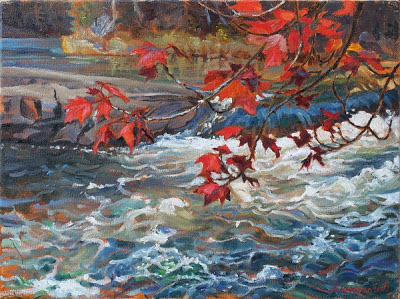Baltimore Oriole (watercolour 5 x 7 in.) Sold
31 July finds me picking up the bright black and orange bird that my van just hit on County Road 20, north of East Oxford, Grenville County, Ontario. It is very sad to have caused the death of one in my own community - a neighbour, even though I had not known the bird personally until holding its hot body in my hand and admiring its vivid breast, noticing the orange inside the head plumage - only the tips of the feathers at the back of the head and neck are black. These feathers are all orange at their bases as if the bird were bursting with orange! The eye is large and dark brown, and the bill is pale blue, as are the sturdy legs and feet. The foot and toe pads are pale creamy yellow.
The first 'going-back-decades-later' project that one of us was associated with, was Fred helping to unpacking the returned loan of Oriole skins for Jim Rising's thesis at the Cornell bird collection when he was an undergraduate there. These were the specimens that Sibley and Short collected in the 1950's when they first documented hybridization between the Baltimore and Bullocks Orioles in the Great Plains, and Jim was comparing them with those he had collected himself. Jim came to Cornell as a post-doc and continued to work with contemporary evolutionary change among hybridizing birds, and Fred followed him to the University of Toronto to be his first graduate student.
It seems that there has been an evolution of car-caution among song birds. We used to see many more dead on the roads and as I paint this bird, I realize that it is in a way, an illustration of an individual whose road-crossing habit has been selected against. (see Fred's 2008 essay, Ten Other Questions about Road Ecology. Question 7 asks "how much evolution of car-caution has there been?"





Interesting about the head feathers being only black tipped. It's as if the black is being selected for, and the bird is currently in the process of evolving towards having the black head!
ReplyDeleteI like the way you curved the thin washy bottom edge, providing volume to the breast -- rather than maybe a more conventional straight-across "vignette" edging.
Of course, the eye is beautiful, but I expect that from you. :)
I always put a blue wash over the eye first - all except the main highlight. Then I paint the iris colour in a wash over that, keeping it light through a crescent of dull bluish reflected light around the bottom, usually opposite the main highlight. Then I paint the black iris, sometimes making a blue edge on the main highlight. There is often a bit of moisture between the surface of the eye and the eyelid, so may I add a small dot or two of opaque white there, which emphasizes the eyelid and helps to make the eye look sharp and alive.
ReplyDelete